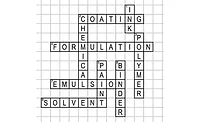Moody's Coatings Conundrums: Saul’s Un-Sellable Formulation

“What do you mean, we can’t sell the formulation?” Saul Vance asked, not believing what he was hearing from his supervisor. Wyatt Walsh, had called him into his office before he even had time to turn on the lights, ovens and equipment in his formulation lab that morning. Now, Wyatt was telling him, reading from the note on his computer, that the formulation that Saul had developed and tested was being pulled from the market. Saul took this news very personally after all the work he had put into the formulation. His formulations were his own creations, the result of trying different combinations to get just the right ingredients that gave the properties needed by his customers. Each of Saul’s formulations were precisely put together to meet the application requirements. Saul took pride in being able to formulate specific properties into his mixtures. Now his boss and mentor, Wyatt, was telling him he had messed up on his formulation and it had to be pulled.
Saul Vance sat down hard in the one chair in front of Wyatt’s desk surprised and shocked at the news. As Wyatt’s voice droned on in the background, Saul began to remember the call he had gotten about three weeks earlier from the Purchasing Director, Lois Bidder. Lois had worked in the lab for a short time with Saul, but was now over the entire purchasing department. Lois was known for pricing formulations lower than all the competition and had been promoted quickly within the procurement organization. Saul remembered being surprised when Lois had asked about the formulation and was now complaining about the high cost of the ingredients. Lois said that the cost of the formulation was too high for the market. Saul didn’t like it when Lois Bidder, or anyone else in purchasing, complained about his formulations, especially when the complaining was not based on performance but simply on wanting a cheaper version. Every ingredient was in there for a reason and they all worked together in harmony, like a well-oiled machine.
As Wyatt was winding up his lecture on formulating coatings, one that Saul had heard a thousand times before, Saul remembered that Lois had asked if he had looked at using any different solvents. Saul had told Lois that the solvent he used in the formulation gave the best combination of properties. The primary solvent Saul had chosen for the formulation was a proprietary ketone solvent. Lois had been buying another solvent, an ester solvent, in large bulk quantities and this solvent was used in many of Saul’s formulations. Because of buying the ester solvent in bulk, the company got a very low price. She asked Saul if he had tried the cheaper ester, PM acetate, in his formulation. PM acetate was a commodity solvent that had a similar evaporation rate to the ketone solvent. Saul was surprised when Lois remembered from her days in the lab that the activity of the two solvents in many acrylic resins was very similar. She also knew from her purchasing role that the acrylic in the formulation was supplied by the manufacturer in PM acetate at 85% solids, so the cheaper solvent was compatible with the acrylic binder resin. Saul, now getting a little irritated with Lois, and wanting to end this conversation, had admitted to her that the application properties of the formulation didn’t change much when he initially used PM acetate, but the ketone made for a better overall formulation. Specifically, he told Lois that the in-can viscosity and the flow out of the film were almost identical with the two different solvents, but the ketone solvent, methyl amyl ketone (MAK), gave better spray out, appearance and coating properties. When Saul hung up the phone with Lois, he thought that she was satisfied with his explanation and didn’t hear any more from Lois about the formulation. But now, Wyatt was telling him that the same formulation Lois had asked about couldn’t be sold.
As Saul was leaving Wyatt’s office, Wyatt handed Saul the printout of the formulation and gave him one week to correct it. Saul glanced at the simple formulation on the paper in front of him and suddenly realized what had happened. Lois, in order to save cost, had resubmitted his formulation with one important change. She had taken out the ketone solvent and replaced it with PM acetate. She had done this without notifying the lab. Since the only change was this direct, pound for pound change, from the ketone solvent to the acetate solvent, Lois thought that the formulation cost would be less. And after her phone conversation with Saul, Lois knew that there would be only minor changes in the performance of the coating.
Since Saul had done all the work and shown that the properties of the coatings changed very little with the change in the two different solvents, why was the formulation pulled from the market? Why did this change in solvent make the formulation no longer sellable, even though the properties were so similar?
Looking for a reprint of this article?
From high-res PDFs to custom plaques, order your copy today!






